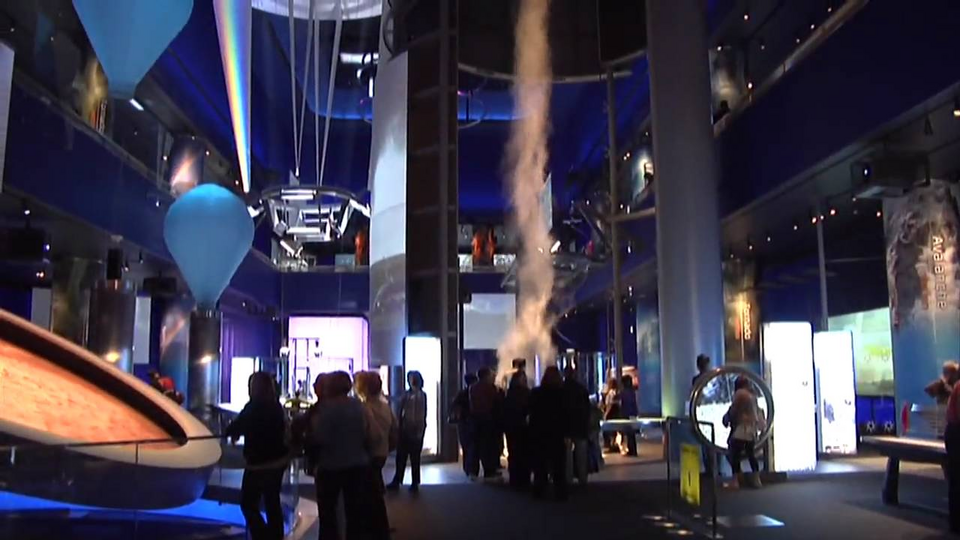Press
Science Storms- Press Releases
- Christmas Around the World and Holidays of Light 2025
- Powering the Future
- New Chief Development Officer, Daniel Solow
- Beyond the Surface: The Art of X-rays
- Marvel's Spider-Man: Beyond Amazing – The Exhibition
- Steelmakers Exhibition
- South Portico Renovation
- Introducing the Kenneth C. Griffin Museum of Science and Industry
- SpaceX Dragon Spacecraft
- 007 Science: Inventing the World of James Bond
- Media Requests
Science Storms

NATURAL PHENOMENA TAKE GUESTS BY STORM AT Griffin MSI
CHICAGO (March 18, 2010)—Be blown away by a 40-foot tornado swirling before you. See bolts of lightning crack over your head. Trigger an avalanche. Unleash a tsunami wave.
It’s all possible in Science Storms, an unprecedented and dramatic permanent exhibit in Allstate Court that reveals the extraordinary science behind some of nature’s most powerful and compelling phenomena—tornados, lightning, fire, tsunamis, sunlight, avalanches and atoms in motion. Science Storms was awarded the Excellence in Exhibition award in 2011, the top honor by the American Association of Museums.
“Creating transformative experiences that get people excited about the world around them is what the Griffin Museum of Science and Industry does best, and exhibits like Science Storms are our most powerful teaching tools,” said David Mosena, president and CEO of the Griffin Museum of Science and Industry.
Inside the 26,000-square-foot exhibit, you’ll investigate the basic principles of chemistry and physics that are responsible for nature’s biggest wonders, while you get a hands-on, up-close look at these wonders themselves. Science Storms puts you in the middle of the action and lets you search for answers as to how and why things happen in nature.
- Immerse yourself in a 40-foot tornado to experiment with air pressure and wind speed inside a towering vortex of vapor.
- Create a high-voltage lightning storm by discharging volts of energy from a giant Tesla coil, 20 feet in diameter, to discover electricity and magnetism.
- Ignite and control fires within a glass cube to witness the flame’s behavior and reaction to different conditions.
- Make your own giant rainbows with optical prisms, recreating Newton’s famous prism experiment to observe the physical nature of light.
- Transform water into vapor, then into ice and back to water again to explore states of matter.
- Trigger a 20-foot avalanche to reveal the beauty of granular dynamics.
- Discover the power and motion of waves by unleashing your own tsunami across a 30-foot wave tank.
As you investigate each of these forces of nature, you’ll experience dynamic media presentations that explore the science behind the phenomena—featuring leading researchers and scientists from NASA, NOAA, the United States Geological Survey, Harvard University, the University of Chicago and many more. Interspersed throughout the exhibit are important artifacts that help you to further understand the various scientific principles at work. Among them, you’ll see:
- The oil drop apparatus that Robert Millikan used in his 1923 Nobel prize-winning experiment to measure the charge of a single electron for the very first time.
- A giant Deep Ocean Assessment and Reporting of Tsunamis (DART) buoy used for detecting tsunamis and transmitting warnings. The buoy, decommissioned by the National Oceanic and Atmospheric Administration (NOAA) in 2008, recorded a tsunami resulting from an 8.3-magnitude earthquake in the Kuril Islands in Russia.
- A light bulb that was used at the historic 1879 New Year’s Eve demonstration of the Edison Lighting System in Menlo Park, New Jersey. This was the first time light bulbs were lit for the public.
Science Storms is brought to you through the generosity of The Allstate Corporation, The Allstate Foundation, Mr. and Mrs. David W. Grainger and The Grainger Foundation. Additional major funding is provided by the U.S. Department of Energy.
Science Storms is included in Museum Entry.
About Kenneth C. Griffin Museum of Science and Industry
Kenneth C. Griffin Museum of Science and Industry (Griffin MSI) offers world-class and uniquely interactive experiences that support the Museum's mission: to inspire the inventive genius in everyone. As one of the largest science museums in the world featuring award-winning exhibits and hands-on activities, a visit to Griffin MSI is guaranteed to connect fun and learning. Griffin MSI is committed to offering comprehensive educational programs for students, administrators, teachers and families that make a difference in local communities and contribute to Griffin MSI's goal to transform and illuminate STE(A)M (science, technology, engineering, art and math) pathways for people of all ages. The Museum is grateful for the support of generous donors and guests who make its work possible. Griffin MSI is also supported in part by the people of Chicago through the Chicago Park District. For more information, visit msichicago.org or call (773) 684-1414.
Press Photos
Explore the amazing science behind natural phenomena with more than 50 different hands-on activities in Science Storms.
[J.B. Spector/Griffin Museum of Science and Industry]
Guests observe the exhibit’s 20-foot avalanche disk to study the motion of granules.
[J.B. Spector/Griffin Museum of Science and Industry]
The exhibit’s Tesla Coil discharges lightning strikes using more than 1.2 million volts of electricity.
[J.B. Spector/Griffin Museum of Science and Industry]
Investigate how waves travel and interact with objects using large, interactive ripple tanks.
[J.B. Spector/Griffin Museum of Science and Industry]
Guests can manipulate a 40-foot tornado to experiment with air pressure and wind speed inside a towering vortex of vapor.
[J.B. Spector/Griffin Museum of Science and Industry]
Guests can make giant rainbows with optical prisms, recreating Newton’s famous prism experiment to observe the physical nature of light.
[J.B. Spector/Griffin Museum of Science and Industry]
Images presented here are for the express use for promoting the Griffin Museum of Science and Industry. All images must be properly credited. Images may not be reproduced by third parties without express written permission from the Griffin Museum of Science and Industry.





